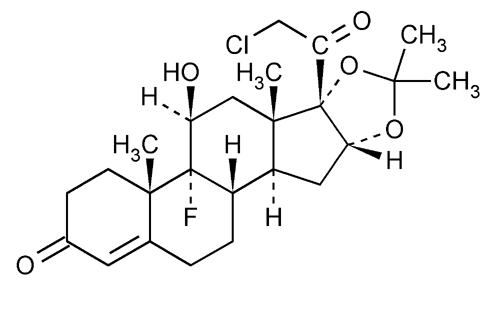Halcinonide
Pregn-4-ene-3,20-dione, 21-chloro-9-fluoro-11-hydroxy-16,17-[(1-methylethylidene)bis(oxy)]-, (11
21-Chloro-9-fluoro-11
» Halcinonide contains not less than 97.0 percent and not more than 102.0 percent of C24H32ClFO5.
Packaging and storage—
Preserve in well-closed containers.
Identification, Infrared Absorption  197K
197K .
.
Loss on drying  731
731 —
Dry it in vacuum at 100
—
Dry it in vacuum at 100 for 3 hours: it loses not more than 1.0% of its weight.
for 3 hours: it loses not more than 1.0% of its weight.
Residue on ignition  281
281 :
not more than 0.2%.
:
not more than 0.2%.
Chromatographic purity—
Prepare the test solution by dissolving 50 mg of Halcinonide in 5.0 mL of a mixture of chloroform and methanol (1:1). Divide the area of a suitable thin-layer chromatographic plate (see Chromatography  621
621 ) coated with a 0.25-mm layer of chromatographic silica gel mixture, into three equal sections, the first two sections to be used for the test solution and the third section for the blank. Apply 100 µL of the test solution to appropriate sections of the plate, drying each solution as it is applied with a current of warm air. Using a continuous elution chromatographic chamber, develop the chromatogram in a solvent system consisting of a mixture of chloroform and ethyl acetate (5:1) for about 2 hours. Remove the plate from the developing chamber, dry in an oven at 90
) coated with a 0.25-mm layer of chromatographic silica gel mixture, into three equal sections, the first two sections to be used for the test solution and the third section for the blank. Apply 100 µL of the test solution to appropriate sections of the plate, drying each solution as it is applied with a current of warm air. Using a continuous elution chromatographic chamber, develop the chromatogram in a solvent system consisting of a mixture of chloroform and ethyl acetate (5:1) for about 2 hours. Remove the plate from the developing chamber, dry in an oven at 90 for 15 minutes, and locate the bands by viewing under short-wavelength UV light. Mark the principal band and any secondary bands. Quantitatively remove the silica gel containing these bands, including a corresponding blank segment, and transfer to separate glass-stoppered, 50-mL centrifuge tubes, combining the impurities if more than one impurity is present. Add 30.0 mL of dehydrated alcohol to the tubes containing the principal band and the corresponding blank, and add 10.0 mL of dehydrated alcohol to the tubes containing the combined impurities and the corresponding blank. Insert stoppers in the tubes, and shake gently on a reciprocating shaker for about 60 minutes. Centrifuge, dilute the principal band eluate and its corresponding blank eluate with an equal volume of dehydrated alcohol, and mix. Determine the absorbances of the clear supernatant eluates in 1-cm cells at the wavelength of maximum absorbance at about 239 nm, with a suitable spectrophotometer, using dehydrated alcohol as the blank. Calculate the percentage of chromatographic impurities by the formula:
for 15 minutes, and locate the bands by viewing under short-wavelength UV light. Mark the principal band and any secondary bands. Quantitatively remove the silica gel containing these bands, including a corresponding blank segment, and transfer to separate glass-stoppered, 50-mL centrifuge tubes, combining the impurities if more than one impurity is present. Add 30.0 mL of dehydrated alcohol to the tubes containing the principal band and the corresponding blank, and add 10.0 mL of dehydrated alcohol to the tubes containing the combined impurities and the corresponding blank. Insert stoppers in the tubes, and shake gently on a reciprocating shaker for about 60 minutes. Centrifuge, dilute the principal band eluate and its corresponding blank eluate with an equal volume of dehydrated alcohol, and mix. Determine the absorbances of the clear supernatant eluates in 1-cm cells at the wavelength of maximum absorbance at about 239 nm, with a suitable spectrophotometer, using dehydrated alcohol as the blank. Calculate the percentage of chromatographic impurities by the formula:
100Ai / (Ai+6Au)
in which Ai is the absorbance of the combined impurity bands eluate, corrected for the corresponding blank; and Au is the absorbance of the principal band eluate, corrected for the corresponding blank. Not more than 3.0% is found.
Assay—
Standard preparation—
Dissolve an accurately weighed quantity of USP Halcinonide RS in methanol, and dilute quantitatively and stepwise with methanol to obtain a solution having a known concentration of about 15 µg per mL.
Assay preparation—
Weigh accurately about 30 mg of Halcinonide, transfer to a 100-mL volumetric flask, dissolve in methanol, dilute with methanol to volume, and mix. Transfer 5.0 mL of this solution to a second 100-mL volumetric flask, dilute with methanol to volume, and mix.
Procedure—
Concomitantly determine the absorbances of the Assay preparation and the Standard preparation in 1-cm cells at the wavelength of maximum absorbance at about 239 nm, with a suitable spectrophotometer, using methanol as the blank. Calculate the quantity, in mg, of C24H32ClFO5 in the portion of Halcinonide taken by the formula:
2C(AU / AS)
in which C is the concentration, in µg per mL, of USP Halcinonide RS in the Standard preparation; and AU and AS are the absorbances of the Assay preparation and the Standard preparation, respectively.
Auxiliary Information—
Please check for your question in the FAQs before contacting USP.
| Topic/Question | Contact | Expert Committee |
| Monograph | Clydewyn M. Anthony, Ph.D.
Scientist 1-301-816-8139 |
(MDCCA05) Monograph Development-Cough Cold and Analgesics |
| Reference Standards | Lili Wang, Technical Services Scientist 1-301-816-8129 RSTech@usp.org |
USP32–NF27 Page 2546
